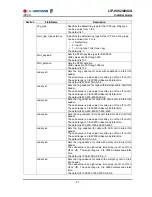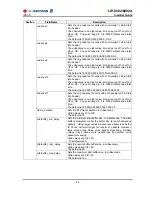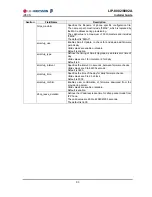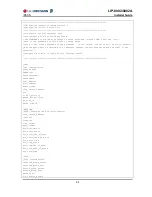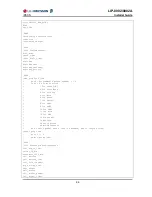
LIP-8002/8002A
iPECS
Installer
Guide
100
After completing download of the configuration files, the IP Phone requests the software version
file from the server. This file, which is named “IP_8002_VER_SIP2”, is an ASCII text file that
identifies the software version available on the server as well as the names of software files to
be downloaded. The phone compares the software version identified in the file with the version
in the phone. If different, the files identified in the version file are downloaded. Typically, the
files required for download include the main firmware file and an xml file but may include other
files as needed for the upgrade. These files along with the version file are available from LG-
Ericsson. If desired, comments may be added to the version file using “#” as the leading
character of the comment line.
If software download is required, the IP Phone will enable the reboot flag and after completing
the download cycle, the IP Phone reboots.
HTTP/HTTPS downloads
When HTTP/HTTPS is employed, the IP Phone will contact the URL defined in the memory or in
the HTTPS DHCP Option, default #160. When the DHCP option is populated, the phone
employs HTTP/HTTPS instead of the default TFTP mode. If the server uses HTTPS, the phone
will establish an open SSL link. During the SSL handshake, the phone may optionally verify that
the validity of the HTTPS Certificate of Authority (CA). The IP Phone verifies that the CA is from
a valid authority such as Verisign
®
, the server providing the CA is correct and the certificate has
not expired. The latter is verifiable only if an SNTP server provides time to the IP Phone. Each
of these three verifications is enabled by default but can be disabled using the configuration file
or manual configuration. The IP Phone supports several standard CAs including Verisign
®
. In
addition, a CA may be copied to the phone using the Web Manager.
If the HTTP/HTTPS server requires authentication, the IP Phone uses the HTTPS ID and
Password assigned; the IP Phone supports the basic and digest method. At this point, the
phone will follow the same routine as for TFTP. The IP Phone requests the global configuration
file (“sysconf_8002_sip.cfg”). If the file is provided as an unencrypted file, data is transferred to
memory.
Changes in the provisioning data from the global configuration file are transferred to the phone
memory and the download process is repeated for the phone-specific file. Configuration data in
the phone specific file overwrites data from the global file.
Note if a value is changed for a field marked with an asterisk in
Table D-1
, the reboot flag will be
enabled and the IP Phone will reboot after the download cycle is completed. By default, the
phone specific file uses the MAC address of the phone as the file name with no file extension.
For HTTP/S, a different file name can be assigned in the phone to use as file name but the MAC
address must be included as part of the file name or path.
After completing download of the configuration files, the IP Phone requests the software version
file from the server. This file, which is named “IP_8002_VER_SIP2”, is an ASCII text file that
identifies the software version available on the server as well as the names of the files for


